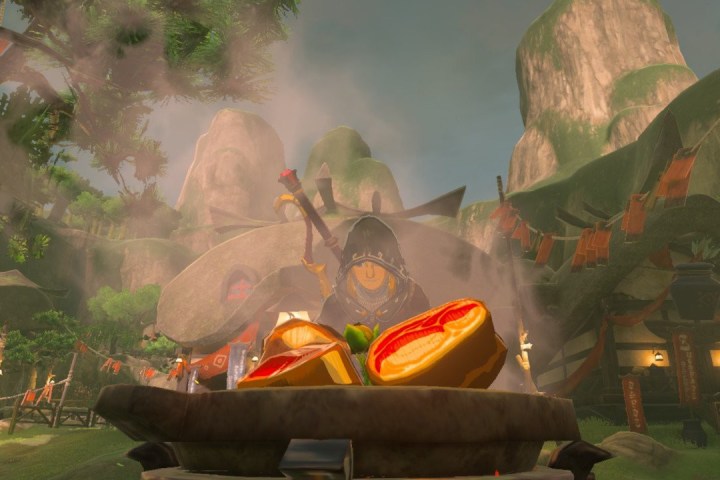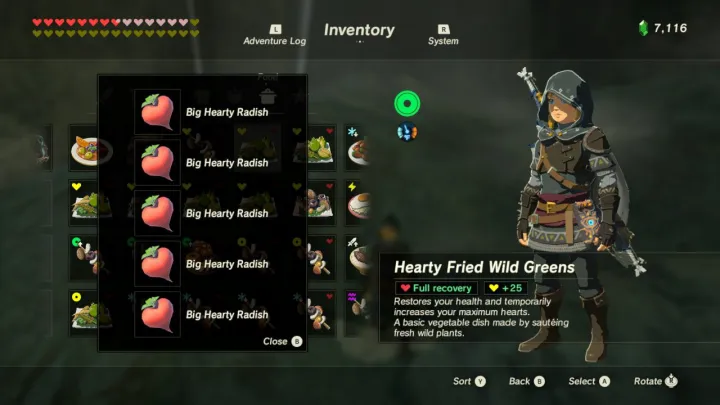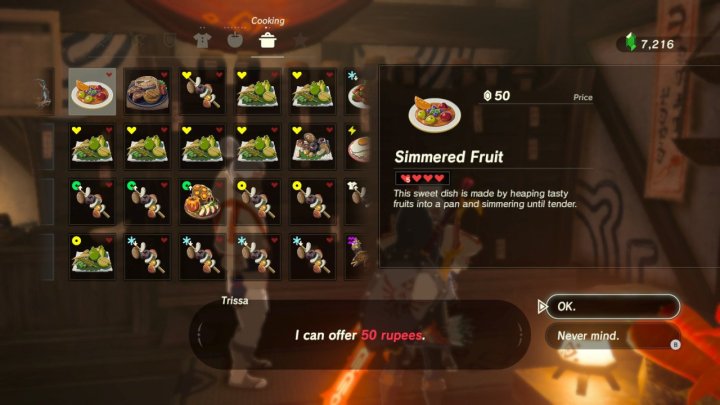
But you might not realize just how great Breath’s cooking system is if you haven’t quite grasped its ins and outs. Like in most cases, this new Zelda game doesn’t go out of its way to explain how to cook, inviting you to experiment and find out for yourself.
If that isn’t your bag, let us be your culinary guides through the land of Hyrule: We’ll teach you the ins and outs of the cooking system so you can get out of the frying pan and bring the fire to all those bokoblins, moblins, and lizalfos all over Hyrule.
Hunting and gathering
Before you can start cooking in Breath of the Wild, you need to have something to throw in the pot. Luckily, you can grab ingredients almost constantly, while fighting enemies, climbing trees, or simply running around in the woods. Almost everything you pick up that isn’t a weapon, bow, or shield, can be used to cook, although the results vary wildly depending on what you use.
So first thing’s first — it’s important to know what different kinds of ingredients do:
Fruits and vegetables
Fruits and veggies, from the common apple and Hylian shroom, to the rare hearty radish, are the most common overall ingredients in Hyrule. Many can be eaten raw to gain a small amount of health, but cooking them always adds to their healing properties.
Many also have a secondary effect that can only be unlocked via cooking. The common Stamella Shroom, for example, provides stamina regeneration, but only if you throw it in a pot first. Make sure to read the description for every ingredient you pick up to discover whether it has extra effects.
Suggested recipe: I love simply stacking mushrooms. Five stamella shrooms make a stamina-regen skewer. I always carry back-ups in case I run out of stamina while climbing or swimming.

Surf and turf
Meat and seafood fall into separate categories. Most raw meat, dropped when you kill animals like deer, foxes, and herons, has a healing effect that can be augmented through cooking. Seafood can be used to make a healing dish, and usually adds other effects as well. Mighty carps, for example, can increase your attack power, while armored carps can increase your defense. This category also includes things like sea snails and crabs, and the same rules apply. Like every other ingredient, these effects are unlocked only through cooking.
Recipe ideas: Cook any meat with rock salt to increase its effects, or combine meat and seafood to make stir fries.
Herbs, nuts, spices, and more
These general ingredients range from the common Hyrule herb to specialty items like Safflina herbs with various properties (“warm,” “cool” and “electric”), as well as things like eggs, acorns, rock salt, and milk. Most herbs and spices don’t create a healing item when cooked alone, but can add a huge variety of effects on fruit-, vegetable-, meat-, and fish-based dishes, so pay attention to their descriptions and don’t be afraid to experiment.
Recipe ideas: Try adding these ingredients to recipes as you would in real life — add herbs and spices to meat dishes, and honey to fruit. An egg cooked with rice makes eggs and rice (duh), and adding another ingredient — like a zapshroom — adds electric resistance. You can make cakes or pies by combining goat butter, Tabantha wheat, cane sugar, and other ingredients. Who wants dessert?
Bugs and other critters
Hyrule is brimming with dragonflies, beetles, butterflies, frogs, and lizards, which can be caught without needing to attack them first. For the most part, you will need to sneak up on these ingredients to catch them.
They can also be differentiated by their item descriptions: one and all, they must be combined with monster parts, rather than food ingredients. This produces elixirs, rather than typical dishes, which generally have more potent properties but lack the healing qualities of cooked food.
Recipe ideas: Combine bugs that have an elemental affinity — like warm, cool or electric darners — with monster parts to get elixirs that will grant you specific resistances. Common hot-footed frogs can make speed boost elixirs.

Monster parts
Monster parts include anything dropped by monsters when you defeat from, from Bokoblin guts to Octo balloons. You can combine them with bugs and other critters to make potent elixirs. The rule here is simple: the more rare the monster parts, the better the elixir will turn out.
However, many monster parts are also useful for a lot of other things besides cooking so, especially in the early game it’s smart to focus on normal food. That said, it never hurts to carry some elixirs around just in case.
Suggested recipe: See above.
How cooking works
Breath of the Wild mostly leaves you to figure cooking out for yourself. The basics are simple: Select an ingredient from your inventory and tell Link to “hold” it in his arms. You can select up to five items; pick the items you want, then exit the menu. With Link holding the ingredients, walk up to a cooking pot and press “A” to plop them in the water. Within a few seconds you’ll receive the fruits of your labor.
While the act of cooking is simple, there are many underlying rules dictating the results of your culinary experimentation. Here are some of the basics of cooking Breath of the Wild-style:
Stack ingredients
Whenever you’re in doubt or don’t have a specific recipe in mind, simply stack up to five of the same ingredient in a dish. You’ll get items like “simmered fruit” or “mushroom skewer” that simply multiply the effect of the ingredient in question. Five apples cooked together, for example, provides lots of healing, while a dish cooked with five stamella shrooms greatly replenishes your stamina bar.

Don’t mix effects
Most food you’ll cook will heal you to one degree or another. Depending on the ingredients your meals will also impart one of several possible effects; a temporary increase to your maximum health or stamina, increased attack or defense power, or improved resistances to fire, electricity, freezing, or the ability to endure hot or cold weather. The adjectives attached to ingredients, like “hearty” or “sneaky,” often telegraph this.
When you’re deciding what ingredients to cook together, pay attention to each item’s description and never mix two ingredients that add different effects. If you cook stamina-regenerating mushrooms with electric-resistance fish, you won’t get a dish that fills your stamina bar while granting electric resistance; the effects will cancel each other out. At best the meal will only use one of the effects, and at worst you’ll get some “dubious food” that’s too horrible to look at.
Don’t be afraid to combine ingredients
That said, don’t be afraid to combine different kinds of ingredients. The smartest pairings adhere to two important rules: one, they’re within the same category (so two different kinds of mushroom, or two different kinds of fish), and two, their effects don’t cancel each other out.
It’s usually safe to combine items that simply offer health regen with items that have another effect, which will create meals that regenerate health while also providing the extra boost.
Experiment! But be smart
There are exceptions to the above rules, and it almost always pays to experiment with what you cook in Breath of the Wild. You can experiment intelligently, though — don’t throw all your ingredients in one pot if you’re unsure what the result will be. You don’t want to use all your valuable mushrooms on food that will turn out barely edible.
If you aren’t sure how two items will mix, try using one of each before you stack more in the recipe. That way you’ll know you’ve got a winning formula and won’t waste valuable ingredients.

Advanced cooking tips
In Breath of the Wild, the simplest answer is often the best one. When you’re unsure what to cook, simply throw a bunch of ingredients that seem like they’d go well together in the pot and see what happens.
But if you can feel the master chef in your soul balking at this strategy, there are more cooking techniques that will help you make the most of your ingredients. You may be traveling alone in Breath of the Wild, but your horse will definitely be impressed with your skills.
Find recipes and save them
You can make some complex dishes just by looking at what’s in your inventory and combining things that you think would go well together. Apples and honey make a tasty dessert in real life, for example, and in Zelda they make “energizing honeyed apple” when cooked together — increasing your stamina and health simultaneously.
There are lots of sources for recipes in Breath of the Wild. You can see them plastered as posters on the walls of many stables and other buildings, for example. These visual cooking guides should explain everything necessary to make complex dishes. And whenever someone gives you food — often a reward for saving random travelers from bokoblin attacks out in the countryside — you can examine their ingredients by selecting them in your inventory and choosing the “recipe” option.
While there’s no way to record recipes in the game itself, there’s nothing stopping you from recording your favorites in a Google doc, your phone’s notes app or a good old fashioned notebook.

More ingredients is not necessarily better
Here’s a rule that can sometimes be hard to grasp: more ingredients does not necessarily make a better dish.
While you can combine items to make a more potent dish, adding “big hearty radishes” to one pot isn’t necessarily the best idea. You can wind up with meals sitting in your inventory that say they’ll grant you 25 extra hearts. That sounds great, but it’s way past the maximum health you can possibly have, which makes it total overkill. Cooking them in stacks of two would have provided more dishes with more reasonable effects, and ones you wouldn’t have felt weird about using on a more regular basis.
When in doubt, try cooking stacks of different numbers of the same ingredient. You might find that three or four of the item makes more sense for wherever you’re at in terms of total hearts and overall progress, and you’ll conserve more ingredients this way.
On top of that, it’s not always necessary to cook a complicated five-star meal. If you have lots of ironshrooms, just cook a bunch of them together to make a super potent defense-boosting skewer that you can save for a seriously dire battle. Similarly, you can cook spicy peppers with fish and meat to make a health-regenerating stirfry that also grants cold resistance — or you can just cook five spicy peppers together to get an even more potent effect.
Some complex recipes
Here are some complex recipes you can use to flex your kitchen muscles and use some of those less obvious ingredients:
Apple pie: Combining Tabantha wheat, goat butter, and cane sugar makes pie or cake depending what other ingredients you add. Use apples for the classic apple pie.
Fried bananas: Tabantha wheat and cane sugar combined with bananas can make valuable attack-boosting fried bananas.
Curry: Make vegetable or meat curries by combining Hylian rice, Goron spice and additional vegetable or meat ingredients.
Rice balls: Mix rice and salt with other ingredients, like mushrooms, to make tasty Japanese style rice balls.
Clam chowder: Milk, wheat and butter combined with most seafood makes a dish called “meuniere” (Nintendo really went deep on the culinary references). But if you add hearty blueshell snail specifically to the three base ingredients you get the classic clam chowder.
Omelettes: Combine eggs with other ingredients to make omelettes. Try adding goat butter and rock salt as well.
Risotto: Mix Hylian rice, goat butter and rock salt with basically any other ingredient for a nice risotto.

Pick the right kitchen
If you’ve ventured to the Goron homeland of Death Mountain you may have noticed something funny: animals you kill there drop meat that’s often already cooked by the time you pick it up.
That’s an effect known in Breath of the Wild as “roasting.” Because the environment is so hot, ingredients left on the ground will cook on their own. You can get the same effect by simply throwing ingredients on a makeshift fire without a cook pot if you’re in dire straits.
However this won’t give you the ingredients’ full effects. Roasting food will generally boost its healing properties, but other effects, like stamina regen and buffs or resistances, won’t be applied. If a cook pot is available that’s always the better option.
There’s a similar effect in icy environs like the Hebra mountains; ingredients left out in the snow or placed in freezing water will turn into “frozen” food. For most items that’s not a good thing, but (as a loading screen hint may tell you) there are a scant few ingredients that actually do benefit from being frozen (though I’m not sure which ones to be honest).

Cook for a living
As an aspiring master chef it is actually possible to live your dream in The Legend of Zelda: Breath of the Wild: you can cook for a living. Selling your dishes and elixirs is a great way to earn cash. Cooking increases the potency of your ingredients, and in many cases also increases their value when sold in shops.
The best place to set up shop is Kakariko Village, where there’s a cook pot located just outside the house of an enthusiastic ingredient vendor. Whenever you have a surplus of ingredients and a shortage of rupees, head to Kakariko and cook whatever comes to mind. It’s a great way to experiment, and you can sell whatever you don’t need to the lady in the hut. She is literally always overjoyed at your creations, even if it’s just a fried egg or mushroom skewer.
Have fun
Whether you’re cooking for cash or simply trying to survive in the wilds of Hyrule, Breath of the Wild’s cooking system is robust and flexible enough that you should be able to have fun while doing it.
When in doubt, do what makes the most sense for the ingredients you have on hand, and pay attention to items’ descriptions and you’ll rarely go wrong. Ingredients generally do what they say they’ll do, and common sense goes a long way in Zelda: Breath of the Wild.
Editors' Recommendations
- Best Nintendo Switch deals: consoles, games, and accessories
- How to find the Fifth Sage in Zelda: Tears of the Kingdom
- How (and where) to trade Poes in Zelda: Tears of the Kingdom
- The Legend of Zelda: Tears of the Kingdom DLC is not happening, says Nintendo
- The best places to find Purple, Ice, Pink and Rock Pikmin in Pikmin 4


